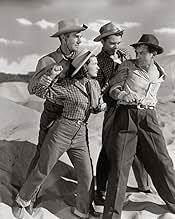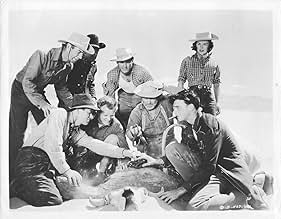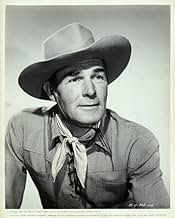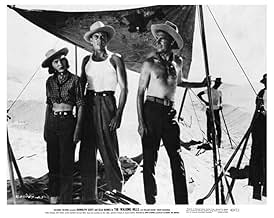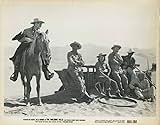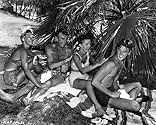NOTE IMDb
6,4/10
1,2 k
MA NOTE
Ajouter une intrigue dans votre langueA group of treasure hunters search for a wagon load of gold, buried years before in Death Valley.A group of treasure hunters search for a wagon load of gold, buried years before in Death Valley.A group of treasure hunters search for a wagon load of gold, buried years before in Death Valley.
- Réalisation
- Scénario
- Casting principal
Ralph Dunn
- Detective
- (non crédité)
Ray Jones
- Rodeo Spectator
- (non crédité)
John McKee
- Bronc Handler
- (non crédité)
Frank Merlo
- Bronc Handler
- (non crédité)
Jack Parker
- American Customs Guard
- (non crédité)
Charles Stevens
- Cleve
- (non crédité)
Frank Yaconelli
- Bartender
- (non crédité)
Avis à la une
This is a really interesting picture. In almost all respects it represents a transition from 1940's film noir to 1950's new age angst - in buckskin and boots.
It stars a diverse group of slightly shady characters who accidentally meet up in a Mexican border town and stumble across a possible fortune out in the desert. The supporting cast is first rate with John Ireland, Edgar Buchanan (as the grizzled old prospector), William Bishop, and Arthur Kennedy. The lead is Randolph Scott with the luscious Ella Raines as the love interest. Too many people underestimate Randolph Scott. They describe his acting as robotic or wooden. His range as microscopic. I even have a brother who questions his sexual orientation. I think he is underrated. He represents, to me, an all American hero in the mold of John Wayne. Whether he's in fatigues or in the saddle, his steely eyed, square jawed performance always adds something to the production. Ella Raines likewise managed to create a smoldering, sexy presence in way too many second rate movies.
This is a contemporary Western (1949) with a clearly modern twist. Not just a falling out between thieves, but an intricate, complicated plot with lots of flashbacks and character development. Most of the principal players spend valuable time beating themselves up for mistakes they made. For a bunch of coyoots, they seem to be mighty introspective. Yet, it doesn't seem to detract from the overall tension built in to the story.
I won't go into the finale, but if you liked Treasure of the Sierra Madre and you're fascinated by the legend of The Lost Dutchman Mine, tune in. You won't be disappointed.
It stars a diverse group of slightly shady characters who accidentally meet up in a Mexican border town and stumble across a possible fortune out in the desert. The supporting cast is first rate with John Ireland, Edgar Buchanan (as the grizzled old prospector), William Bishop, and Arthur Kennedy. The lead is Randolph Scott with the luscious Ella Raines as the love interest. Too many people underestimate Randolph Scott. They describe his acting as robotic or wooden. His range as microscopic. I even have a brother who questions his sexual orientation. I think he is underrated. He represents, to me, an all American hero in the mold of John Wayne. Whether he's in fatigues or in the saddle, his steely eyed, square jawed performance always adds something to the production. Ella Raines likewise managed to create a smoldering, sexy presence in way too many second rate movies.
This is a contemporary Western (1949) with a clearly modern twist. Not just a falling out between thieves, but an intricate, complicated plot with lots of flashbacks and character development. Most of the principal players spend valuable time beating themselves up for mistakes they made. For a bunch of coyoots, they seem to be mighty introspective. Yet, it doesn't seem to detract from the overall tension built in to the story.
I won't go into the finale, but if you liked Treasure of the Sierra Madre and you're fascinated by the legend of The Lost Dutchman Mine, tune in. You won't be disappointed.
Excellent western ,where what is apparently the main subject (the search for gold) is actually of secondary importance in the end.The director is much more interested in his characters and the relationships that are formed between them.He superbly films the desert ,which has got something lunar ,disturbing ;the signals in the distance increases this feeling of mystery.Even the flashbacks are strange ,they seem completely out of place (Ella Raines could have told her story ) and they add to the threatening atmosphere.Most of the time,the viewer does not know who is searching who and almost all the action takes place in the same place (apart from the beginning) ,which is very rare in a western.Impressive sand-storm scene.
A very rewarding "lust for gold" adventure that tells its story in a brief 78 minutes and is all the better for it. Director John Sturges would later in his career allow some of his films to run overlong (THE GREAT ESCAPE) or blow up what should have been more simply told (GUNFIGHT AT THE OK CORRAL - the depicted gunfight itself is but one example), but earlier in his career made a number of lean, taut treasures, this is one of them.
A group of people are bound together in the search for some wagons believed to have been lost in the desert a century earlier, and the legend has it that gold was on them. When the youngest of them happens to mention something spotted in the desert, the need for secrecy binds the group together lest someone reveal the "golden opportunity." Several in the group have pasts that they are trying to hide and potential futures they are trying to escape if caught. One of them is a detective hot on a fugitive's trail, but willing to set aside duty for his share of the loot.
Randolph Scott headlines as the more or less moral center of the group, even if his intentions and actions seem to defy that description. For a slightly less than "A" feature, the film boasts an admirable cast of characters, among them Ella Raines, John Ireland, Arthur Kennedy, Edgar Buchanan (scene stealing as usual) and blues/folk revivalist singer Josh White whose musical contributions to the film capture a legendary performer for posterity. William Bishop, a young man whom Columbia was grooming for stardom (but who failed to click and would soon "descend" to mostly TV work) is the least familiar perhaps of the major actors, but he's impressive enough here for one to wish he had done better within the ten years that he had left before cancer took him at 41.
An interesting subplot has Scott's mare about to foal - a metaphor for new life or spiritual rebirth being created among the desert ruins. It gives nothing away to reveal that the fugitive surrenders or that some characters realize that gold fever can cause one to suspend principles - the latter is expected in such melodramas. But with its stunning black-and-white cinematography, especially in night scenes and the climatic desert storm, this film is as much of a treasure as that which its protagonists seek. Camera ace Charles Lawton must have impressed Scott and producer Harry Joe Brown as he would do five more films with the pair in the next decade. Highly recommended.
A group of people are bound together in the search for some wagons believed to have been lost in the desert a century earlier, and the legend has it that gold was on them. When the youngest of them happens to mention something spotted in the desert, the need for secrecy binds the group together lest someone reveal the "golden opportunity." Several in the group have pasts that they are trying to hide and potential futures they are trying to escape if caught. One of them is a detective hot on a fugitive's trail, but willing to set aside duty for his share of the loot.
Randolph Scott headlines as the more or less moral center of the group, even if his intentions and actions seem to defy that description. For a slightly less than "A" feature, the film boasts an admirable cast of characters, among them Ella Raines, John Ireland, Arthur Kennedy, Edgar Buchanan (scene stealing as usual) and blues/folk revivalist singer Josh White whose musical contributions to the film capture a legendary performer for posterity. William Bishop, a young man whom Columbia was grooming for stardom (but who failed to click and would soon "descend" to mostly TV work) is the least familiar perhaps of the major actors, but he's impressive enough here for one to wish he had done better within the ten years that he had left before cancer took him at 41.
An interesting subplot has Scott's mare about to foal - a metaphor for new life or spiritual rebirth being created among the desert ruins. It gives nothing away to reveal that the fugitive surrenders or that some characters realize that gold fever can cause one to suspend principles - the latter is expected in such melodramas. But with its stunning black-and-white cinematography, especially in night scenes and the climatic desert storm, this film is as much of a treasure as that which its protagonists seek. Camera ace Charles Lawton must have impressed Scott and producer Harry Joe Brown as he would do five more films with the pair in the next decade. Highly recommended.
Despite presence of cowboy vet Randy Scott, this is not really a western. Instead it's a modern adventure tale of gold fever. A bunch of disparate saloon characters goes hunting for buried treasure amid treacherous sand dunes of the Southwest. Each has his own reason for going and his own past, so naturally conflicts develop. And, oh yes, lovely Ella Raines shows up on horseback as relief from the ugly guys. Scott's the most level-headed of the bunch, but he's no paragon— is his willingness to abandon the wounded Johnny because of hard-headed realism or selfish greed.
It's an unusual collection of distinctive Hollywood players, including a shifty Kennedy, a nasty Ireland, a sneaky Collins, and, of course, a jovial Buchanan. Too bad the star-crossed William Bishop died too young to establish a screen persona. And how unexpected for blues singer Josh White to turn up as one of the fortune hunters. His musical interludes may seem artificially inserted but are pleasantly entertaining.
For me there are two highlights. The sandstorm, of course, is really well done-- on a set I would assume, but still a marvelously staged effect. The other is that battle of shovels atop a swirling dune, (move over Japanese martial arts). It's like nothing I've seen. Then too, the location staging in Death Valley may send you out for water, so bring a canteen.
Including flashbacks, the narrative itself is pretty crowded for a 78-minute runtime. So don't expect a tight format. Action and characters tend to be sketched through the proverbial glass darkly. Nonetheless, the movie's an unusual production that's remained oddly memorable since my first viewing, lo, so many years ago.
It's an unusual collection of distinctive Hollywood players, including a shifty Kennedy, a nasty Ireland, a sneaky Collins, and, of course, a jovial Buchanan. Too bad the star-crossed William Bishop died too young to establish a screen persona. And how unexpected for blues singer Josh White to turn up as one of the fortune hunters. His musical interludes may seem artificially inserted but are pleasantly entertaining.
For me there are two highlights. The sandstorm, of course, is really well done-- on a set I would assume, but still a marvelously staged effect. The other is that battle of shovels atop a swirling dune, (move over Japanese martial arts). It's like nothing I've seen. Then too, the location staging in Death Valley may send you out for water, so bring a canteen.
Including flashbacks, the narrative itself is pretty crowded for a 78-minute runtime. So don't expect a tight format. Action and characters tend to be sketched through the proverbial glass darkly. Nonetheless, the movie's an unusual production that's remained oddly memorable since my first viewing, lo, so many years ago.
It doesn't take $175 million to make a good movie. Hollywood just squandered $175 million on a stupid comedy called Evan Almighty, which garnered scant public attention. I doubt that John Sturges and Columbia Pictures spend as much as $175 THOUSAND making The Walking Hills; but people are still searching for it on eBay some 60 years later.
Sand dunes are "walking hills" as my family found out in North Carolina when I was 8 years old and we found our motel room at Nags Head 90% buried under the sand, following a gentle storm.
Eight men playing poker in a bar's back room meet a young guy who accidentally blurts out a king sized clue on the whereabouts of a gold carrying wagon train that legend says disappeared in the desert a hundred years earlier. Eight men and one woman (Ella Raines) band together and quietly head out into the desert --- just 8 miles from town --- looking for the gold. The men will battle Mother Nature and each other seeking the gold --- in a story which is relentlessly compelling. Find this movie and watch it.
Sand dunes are "walking hills" as my family found out in North Carolina when I was 8 years old and we found our motel room at Nags Head 90% buried under the sand, following a gentle storm.
Eight men playing poker in a bar's back room meet a young guy who accidentally blurts out a king sized clue on the whereabouts of a gold carrying wagon train that legend says disappeared in the desert a hundred years earlier. Eight men and one woman (Ella Raines) band together and quietly head out into the desert --- just 8 miles from town --- looking for the gold. The men will battle Mother Nature and each other seeking the gold --- in a story which is relentlessly compelling. Find this movie and watch it.
Le saviez-vous
- GaffesAt the end of the picture, just before Ella Raines rides off, she calls Randolph Scott, "Jeff", only his character's name is "Jim".
- Citations
Chris Jackson: [Referring to the large bandage on her forehead] Yeah, until I went bangin' my puss! Now get lost, will ya?
- Bandes originalesYou Won't Let Me Go
Sung by Josh White
Meilleurs choix
Connectez-vous pour évaluer et suivre la liste de favoris afin de recevoir des recommandations personnalisées
- How long is The Walking Hills?Alimenté par Alexa
Détails
- Durée
- 1h 18min(78 min)
- Rapport de forme
- 1.37 : 1
Contribuer à cette page
Suggérer une modification ou ajouter du contenu manquant

